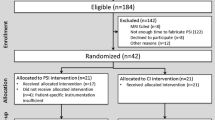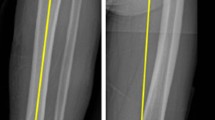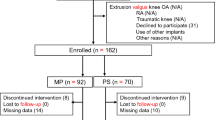Abstract
Purpose
In the present study, the early results of sensor-assisted versus manually balanced posterior-stabilized total knee arthroplasty (TKA) for osteoarthritis with varus deformities were prospectively compared.
Methods
Fifty patients undergoing sensor-assisted TKA (group S) and 50 patients receiving manually balanced TKA (group M) were prospectively compared. The groups did not differ in terms of demographics, preoperative clinical status, or severity of deformity. The knee and function scores (KS and FS), Western Ontario and McMaster Universities Osteoarthritis Index (WOMAC), and range of motion (ROM) were evaluated clinically. The mechanical axes and positions of components were assessed radiographically. In sensor-assisted TKA, the medial and lateral compartment loads were compared based on the patellar positions of inversion and eversion.
Results
There was no between-group difference in the postoperative KS or FS (n.s., respectively). The average postoperative WOMAC score was 17.0 in group S and 18.0 in group M (n.s.). The ROM was 131.2° in group S and 130.8° in group M (n.s.). Neither the postoperative alignment of the mechanical axis nor the component positioning differed between the groups (n.s.). In sensor-assisted TKA, the difference between the medial and lateral compartment loads was less than 15 lbs (6.8 kg) in each knee. The lateral compartment load increased after patellar eversion (p < 0.001).
Conclusion
There are concerns about the cost–benefit ratio of the intraoperative load sensor, despite its advantage of more precisely assessing ligament balance without patellar eversion, which resulted in a smaller lateral gap. A long-term follow-up study with a large cohort is required.
Level of evidence
II.


Similar content being viewed by others
References
Bae DK, Baek JH, Yoon KT, Son HS, Song SJ (2017) Comparison of patellofemoral outcomes after TKA using two prostheses with different patellofemoral design features. Knee Surg Sports Traumatol Arthrosc 25(12):3747–3754
Bae DK, Song SJ, Kim KI, Hur D, Jeong HY (2016) Mid-term survival analysis of closed wedge high tibial osteotomy: a comparative study of computer-assisted and conventional techniques. Knee 23(2):283–288
Bae DK, Song SJ, Kim KI, Hur D, Lee HH (2016) Intraoperative factors affecting conversion from cruciate retaining to cruciate substituting in total knee arthroplasty. Knee Surg Sports Traumatol Arthrosc 24(10):3247–3253
Bae DK, Song SJ, Yoon KH (2010) Total knee arthroplasty following closed wedge high tibial osteotomy. Int Orthop 34(2):283–287
Berend ME, Davis PJ, Ritter MA, Keating EM, Faris PM, Meding JB et al (2010) “Thicker” polyethylene bearings are associated with higher failure rates in primary total knee arthroplasty. J Arthroplast 25(6 Suppl):17–20
Bozic KJ, Kurtz SM, Lau E, Ong K, Chiu V, Vail TP et al (2010) The epidemiology of revision total knee arthroplasty in the United States. Clin Orthop Relat Res 468(1):45–51
Chow JC, Breslauer L (2017) The use of intraoperative sensors significantly increases the patient-reported rate of improvement in primary total knee arthroplasty. Orthopedics 40(4):e648–e651
Elmallah RK, Mistry JB, Cherian JJ, Chughtai M, Bhave A, Roche MW et al (2016) Can we really “feel” a balanced total knee arthroplasty? J Arthroplast 31(9 Suppl):102–105
Ewald FC (1989) The Knee Society total knee arthroplasty roentgenographic evaluation and scoring system. Clin Orthop Relat Res 248:9–12
Geller JA, Lakra A, Murtaugh T (2017) The use of electronic sensor device to augment ligament balancing leads to a lower rate of arthrofibrosis after total knee arthroplasty. J Arthroplast 32(5):1502–1504
Giesinger JM, Hamilton DF, Jost B, Behrend H, Giesinger K (2015) WOMAC, EQ-5D and knee society score thresholds for treatment success after total knee arthroplasty. J Arthroplast 30(12):2154–2158
Gustke K (2012) Use of smart trials for soft-tissue balancing in total knee replacement surgery. J Bone Jt Surg Br 94(11 Suppl A):147–150
Gustke KA, Golladay GJ, Roche MW, Elson LC, Anderson CR (2014) A new method for defining balance: promising short-term clinical outcomes of sensor-guided TKA. J Arthroplast 29(5):955–960
Gustke KA, Golladay GJ, Roche MW, Elson LC, Anderson CR (2017) A targeted approach to ligament balancing using kinetic sensors. J Arthroplast 32(7):2127–2132
Gustke KA, Golladay GJ, Roche MW, Jerry GJ, Elson LC, Anderson CR (2014) Increased satisfaction after total knee replacement using sensor-guided technology. Bone Jt J 96-B(10):1333–1338
Kamei G, Murakami Y, Kazusa H, Hachisuka S, Inoue H, Nobutou H et al (2011) Is patella eversion during total knee arthroplasty crucial for gap adjustment and soft-tissue balancing? Orthop Traumatol Surg Res 97(3):287–291
Kim CW, Lee CR (2018) Effects of femoral lateral bowing on coronal alignment and component position after total knee arthroplasty: a comparison of conventional and navigation-assisted surgery. Knee Surg Relat Res 30(1):64–73
Kwon KT, Han KY, Lee WS, Kim DH (2017) Full cementation in revision total knee arthroplasty using a constrained condylar knee prosthesis with an average 7-year follow-up. Knee Surg Relat Res 29(4):282–287
Lee DH, Lee SH, Song EK, Seon JK, Lim HA, Yang HY (2017) Causes and clinical outcomes of revision total knee arthroplasty. Knee Surg Relat Res 29(2):104–109
Matsumoto T, Muratsu H, Kubo S, Matsushita T, Kurosaka M, Kuroda R (2011) The influence of preoperative deformity on intraoperative soft tissue balance in posterior-stabilized total knee arthroplasty. J Arthroplast 26(8):1291–1298
Matz J, Howard JL, Morden DJ, MacDonald SJ, Teeter MG, Lanting BA (2017) Do changes in patellofemoral joint offset lead to adverse outcomes in total knee arthroplasty with patellar resurfacing? A radiographic review. J Arthroplast 32(3):783–787 e781
Meere PA, LaMont JG, Baez J, Kang MN, Rasquinha VJ, Anderson CR et al (2015) Surgeon assessment of gapping versus kinetic loading using intraoperative sensors during TKA. Reconstr Rev 5(3):29–34
Meneghini RM, Ziemba-Davis MM, Lovro LR, Ireland PH, Damer BM (2016) Can intraoperative sensors determine the “target” ligament balance? Early outcomes in total knee arthroplasty. J Arthroplast 31(10):2181–2187
Na SE, Ha CW, Lee CH (2012) A new high-flexion knee scoring system to eliminate the ceiling effect. Clin Orthop Relat Res 470(2):584–593
Noble PC, Conditt MA, Cook KF, Mathis KB (2006) The John Insall Award: patient expectations affect satisfaction with total knee arthroplasty. Clin Orthop Relat Res 452:35–43
Park CH, Bae DK, Kim KI, Lee JW, Song SJ (2017) Serial changes in the joint space width and joint line convergence angle after closed-wedge high tibial osteotomy. Am J Sports Med 45(14):3254–3261
Pierson JL, Ritter MA, Keating EM, Faris PM, Meding JB, Berend ME et al (2007) The effect of stuffing the patellofemoral compartment on the outcome of total knee arthroplasty. J Bone Jt Surg Am 89(10):2195–2203
Risitano S, Karamian B, Indelli PF (2017) Intraoperative load-sensing drives the level of constraint in primary total knee arthroplasty: surgical technique and review of the literature. J Clin Orthop Trauma 8(3):265–269
Schnaser E, Lee YY, Boettner F, Gonzalez Della Valle A (2015) The position of the patella and extensor mechanism affects intraoperative compartmental loads during total knee arthroplasty: a pilot study using intraoperative sensing to guide soft tissue balance. J Arthroplast 30(8):1348–1353.e1343
Scott DF, Smith RR (2014) A prospective, randomized comparison of posterior stabilized versus cruciate-substituting total knee arthroplasty: a preliminary report with minimum 2-year results. J Arthroplast 29(9 Suppl):179–181
Scott WN, Diduch DR, Long WJ (2018) Insall & Scott surgery of the knee, vol 2, 6th edn. Elsevier, Philadelphia, pp 1766–1769
Sculco P, Gruskay J, Nodzo S, Carrol K, Shanaghan K, Haas S et al (2018) The role of the tourniquet and patella position on the compartmental loads during sensor-assisted total knee arthroplasty. J Arthroplast 33(7S):S121–S125
Sharkey PF, Lichstein PM, Shen C, Tokarski AT, Parvizi J (2014) Why are total knee arthroplasties failing today—has anything changed after 10 years? J Arthroplast 29(9):1774–1778
Yoon JR, Oh KJ, Wang JH, Yang JH (2015) Does patella position influence ligament balancing in total knee arthroplasty? Knee Surg Sports Traumatol Arthrosc 23(7):2012–2018
Yoshino N, Watanabe N, Watanabe Y, Fukuda Y, Takai S (2009) Measurement of joint gap load in patella everted and reset position during total knee arthroplasty. Knee Surg Sports Traumatol Arthrosc 17(5):484–490
Funding
No external funding was used.
Author information
Authors and Affiliations
Corresponding author
Ethics declarations
Conflict of interest
The authors declare no conflict of interest.
Ethical approval
All procecures performed in the studies involving human participants were in accordance with the ethical standards of the institutional and national reareach committee and with the 1964 Helsinki declaration and its later amendments or comparable ethical standards. This study was approved by the Institutional Review Board of our hospital.
Informed consent
A informed consent form was signed by each patient.
Rights and permissions
About this article
Cite this article
Song, S.J., Kang, S.G., Lee, Y.J. et al. An intraoperative load sensor did not improve the early postoperative results of posterior-stabilized TKA for osteoarthritis with varus deformities. Knee Surg Sports Traumatol Arthrosc 27, 1671–1679 (2019). https://doi.org/10.1007/s00167-018-5314-7
Received:
Accepted:
Published:
Issue Date:
DOI: https://doi.org/10.1007/s00167-018-5314-7




